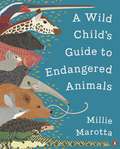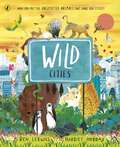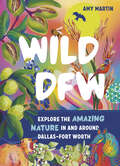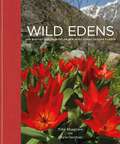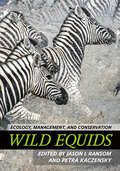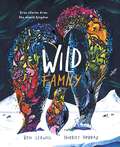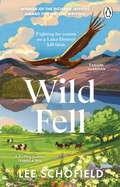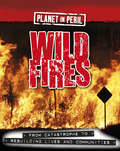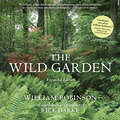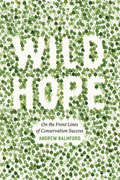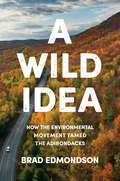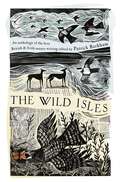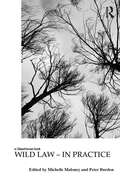- Table View
- List View
Wild Child: A Journey Through Nature
by Dara McAnultyJoin brilliant young naturalist Dara McAnulty – winner of the 2020 Wainwright Prize for his book Diary of a Young Naturalist – on a nature walk and experience the joy of connecting with the natural world on your multi sensory journey. Wild Child: A Journey Through Nature is a beautiful gift book, illustrated in full colour by Barry Falls, and divided into five sections: looking out of the window, venturing out into the garden, walking in the woods, investigating heathland and wandering on the river bank.Dara pauses to tell you about each habitat and provides fantastic facts about the native birds, animals and plants you will find there – including wrens, blackbirds, butterflies, tadpoles, bluebells, bees, hen harriers, otters, dandelions, oak trees and many more. Each section contains a discovery section where you will have a closer look at natural phenomenon such as metamorphoses and migration, learn about categorization in the animal kingdom or become an expert on the collective nouns for birds.Each section finishes with an activity to do when you get home: plant wild flowers, make a bird feeder, try pond dipping, make a journey stick and build a terrarium.Dara ends the book with advice for young conservationists.
A Wild Child's Book of Birds
by Dara McAnultyJoin brilliant young naturalist Dara McAnulty – winner of the 2020 Wainwright Prize for his book Diary of a Young Naturalist and author of Wild Child! – on a journey through a year in the life of birds. A Wild Child's Book of Birds is a fantastic nature book, illustrated in full colour by Barry Falls.This beautiful, informative book takes you through a year in the life of the birds you will find in Britain and Ireland and is divided into four sensational seasonal sections. Find out what birds do in each season, learn about birdsong, beaks, nests and eggs, the science of flight, migration, what to grow to attract different birds to your garden and what foods to put out on your bird table. Learn about different ways of recording what you see and about birds in literature. There are sections on birds of prey and corvids too.
A Wild Child's Guide to Endangered Animals
by Millie MarottaMillie Marotta has always loved the natural world. But in her lifetime much has changed for the animal kingdom. Today we are losing species more quickly than we are discovering new ones. And while we know the plight of the mighty elephant or the charismatic chimpanzee, what of other vanishing species whose stories are not so often told? Mysterious baby dragons of the underworld, the dodo's long-lost cousin, gargantuan lobsters and incredible shrinking reindeer - they too need our help and our attention. With each animal exquisitely illustrated in full colour by Millie, alongside the story of their uniqueness, this is a wonderful and surprising gift, offering the chance to fall more in love with the natural world, and think about how to help save it.
Wild Cities
by Ben LerwillPicture a city. What do you see? Traffic and towering buildings? Or maybe you imagine something a little . . . wilder? These are the astonishing stories of the animals who are adapting to live in our urban world - and how you can help them to thrive. From the pitter-patter of penguins in Cape Town, to the prowl of a leopard in Mumbai, the splash of a seal in Sydney, cities are home to all sorts of unexpected residents. Keep your eyes wide open as as we travel the globe discovering wild cities. With magical illustration and beautiful storytelling, these incredible stories will fascinate every reader who has the travel bug, or is an animal fan, or has ever wondered what else exists in our big cities. Featuring: London, Berlin, Paris, Warsaw, Calgary, New York City, Chicago, Sydney, Beijing, Tokyo, Mumbai, Singapore, Cape Town and Seoul.
Wild City: Encounters With Urban Wildlife
by Florence Wilkinson'The mark of a good nature book is that it opens your eyes to what is there, but you missed, and then to the beautiful possibility of what might be. This is a very good book.' John Lewis-Stempel'An enjoyable and timely reminder that we are never alone' Tristan GooleyThe badgers of Brighton's most exclusive postcode. The water voles of Glasgow. The Black Country bats who have found a haven in old industrial tunnels. The peregrine falcons nesting on the ledges of tower blocks. The mosquitoes found on the London Underground and nowhere else on earth.In Wild City Florence Wilkinson takes us on a fascinating journey into why we should engage with our fellow urban species. What we might see - if we only take the time to look - and how nature is adapting to human-engineered environments in unexpected and ingenious ways.As more and more of our planet is urbanised, we humans still feel that primal pull to connect with our wilder roots. This gorgeously lyrical book invites us to celebrate the natural world, while also offering a clear-eyed glimpse into the challenges faced by urban plants and animals as cities grow and sprawl.Wild City proposes a compelling manifesto for city wildlife, suggesting how we might take action to protect the often-overlooked residents who live alongside us.City-dwellers, it's time to meet your neighbours.
Wild Clay: Creating Ceramics and Glazes from Natural and Found Resources
by Matt Levy Takuro Shibata Hitomi ShibataThe ultimate illustrated guide for sourcing, processing and using wild clay.Potters around the world are taking to the local landscape to dig their own wild clay, discover its unique properties, and apply it to their craft. This guide is the ideal starting point for anyone – from novices, improvers and experts to educators and students – who wants to forge a closer bond between their art and their surroundings.Testing and trial and error are key to finding a material's best use, so the authors' tips, drawn from long experience in the US and Japan (but which can be applied to clays anywhere) provide an enviable head-start on this rewarding journey. A clay might be best suited to sculpture and tile bodies, throwing clay bodies, handbuilding and slab bodies, or simply be applied as a glaze or slip. The specific properties of found materials can create a diverse range of effects and surfaces, or, even when not fired, can be adapted for use as colorful pastels or pigments.Beautiful illustrations and helpful technical descriptions explain the formation of various clays; how to locate, collect and assess them; how to test their properties of shrinkage, water absorption, texture and plasticity; the best ways to test-fire them; and how to adapt a clay's characteristics by blending appropriate materials. From prospecting in the field to holding your finished product, there is helpful advice through every stage, and a gallery of work by international potters who have embraced the clays found around them.
Wild Clay: Creating Ceramics and Glazes from Natural and Found Resources
by Matt Levy Takuro Shibata Hitomi ShibataThe ultimate illustrated guide for sourcing, processing and using wild clay.Potters around the world are taking to the local landscape to dig their own wild clay, discover its unique properties, and apply it to their craft. This guide is the ideal starting point for anyone – from novices, improvers and experts to educators and students – who wants to forge a closer bond between their art and their surroundings.Testing and trial and error are key to finding a material's best use, so the authors' tips, drawn from long experience in the US and Japan (but which can be applied to clays anywhere) provide an enviable head-start on this rewarding journey. A clay might be best suited to sculpture and tile bodies, throwing clay bodies, handbuilding and slab bodies, or simply be applied as a glaze or slip. The specific properties of found materials can create a diverse range of effects and surfaces, or, even when not fired, can be adapted for use as colorful pastels or pigments.Beautiful illustrations and helpful technical descriptions explain the formation of various clays; how to locate, collect and assess them; how to test their properties of shrinkage, water absorption, texture and plasticity; the best ways to test-fire them; and how to adapt a clay's characteristics by blending appropriate materials. From prospecting in the field to holding your finished product, there is helpful advice through every stage, and a gallery of work by international potters who have embraced the clays found around them.
Wild DFW: Explore the Amazing Nature In and Around Dallas–Fort Worth
by Amy MartinDiscover all the unexpected nature Dallas-Fort Worth has to offer with this enlightening guidebook! Dallas-Fort Worth is more than just a bustling metroplex, it&’s full of amazing wildlife. You just need to know where to find it! Equal parts natural history, field guide, and trip planner, Wild DFW has something for everyone. This handy yet extensive guide looks at the factors that shape local nature and profiles over 100 local species, from American basket-flowers and pecan trees to bald eagles, nine-banded armadillos, and Texas spiny lizards. Twenty-five day trips help you find and explore these natural wonders on hiking trails, in public parks, and in your own backyard.
Wild Edens
by Chris Gardner Toby MusgraveExplore the world through a horticultural lens in Wild Edens: an armchair traveller's guide to interesting plants from around the world. Discover the fascinating history and origins of a collection of unique flora, often from hard-to-reach locations in the globe's most abundant biodiversity hotspots, such as Ixia dubia in the Western Cape and the Mediterranean's Crocus biflorus.Each chapter includes a map, personal reflections from the author about exploring these often-remote locations, scene-setting descriptions on topography, geography, climate and flora, key botanical locations within the hotspot, a plant compendium and summary of how the plants impacted garden fashions/styles. Tapping into the revival in interest of nature, gardening and the natural world, this is a premium armchair traveller's guide to interesting plants, flora and fauna from around the world, often from locations that are hard to visit, even without a global pandemic.
Wild Embrace: Connecting to the Wonder of Ireland's Natural World
by Anja Murray"From moss to moths, Anja Murray has conjured up an ebullient paean to our surrounding ecosystem - a sensuous celebration of nature.' MANCHÁN MAGAN'A hugely important, and simply delightful, book.' EOGHAN DALTUN, author of An Irish Atlantic RainforestOPEN UP TO A NOURISHING NEW RELATIONSHIP WITH IRELAND'S WILD WORLD.Wild Embrace is about cultivating curiosity and awe in nature, in a time of eco-anxiety and overwhelm. As ecologist Anja Murray opens our eyes to the hidden bounty of the land, sea and sky around us, we head out on a unique journey through the Irish landscape.She explores the joy of foraging, the marvels of Irish birds, the roles of our native trees in environmental regeneration, nature at night and in the city, and much more - including fascinating insights into our ecological past.With beautiful illustrations by Jane Carkill (@lamblittle), Wild Embrace awakens our senses to the everyday environmental wonders within reach, as we set out on a path to empowered change into the future.
Wild Equids: Ecology, Management, and Conservation
by Jason I. Ransom Petra KaczenskyWild horses, zebras, asses, and feral equines exhibit intriguing and complex social structures that captivate the human imagination and elicit a wide range of emotions that influence conservation and management efforts. This book, spearheaded by Jason I. Ransom and Petra Kaczensky, brings together the world's leading experts on equid ecology, management, and conservation to provide a synthesis of what is known about these iconic species and what needs to be done to prevent losing some of them altogether. The most comprehensive conservation book on wild equids in decades, this title will enlighten not only equid researchers, but also mammalogists, conservationists, and equine professionals. Readers will find new insight into the lives of the world's horses, zebras, and asses, understand the basis of our relationships with these animals, and develop a greater understanding of where equids come from and why they are worth conserving.Included in this book are detailed, state-of-the-science syntheses on Social structure, behavior, and cognition Habitat and diet Ecological niches Population dynamics Roles of humans in horse distribution through time Human dimensions and the meaning of wild Management of free-roaming horses Captive breeding of wild equids Conservation of wild equids Conservation of migrations Reintroductions Genetics and paleogenetics
Wild Equids: Ecology, Management, and Conservation
by Jason I. Ransom Petra KaczenskyWild horses, zebras, asses, and feral equines exhibit intriguing and complex social structures that captivate the human imagination and elicit a wide range of emotions that influence conservation and management efforts. This book, spearheaded by Jason I. Ransom and Petra Kaczensky, brings together the world's leading experts on equid ecology, management, and conservation to provide a synthesis of what is known about these iconic species and what needs to be done to prevent losing some of them altogether. The most comprehensive conservation book on wild equids in decades, this title will enlighten not only equid researchers, but also mammalogists, conservationists, and equine professionals. Readers will find new insight into the lives of the world's horses, zebras, and asses, understand the basis of our relationships with these animals, and develop a greater understanding of where equids come from and why they are worth conserving.Included in this book are detailed, state-of-the-science syntheses on Social structure, behavior, and cognition Habitat and diet Ecological niches Population dynamics Roles of humans in horse distribution through time Human dimensions and the meaning of wild Management of free-roaming horses Captive breeding of wild equids Conservation of wild equids Conservation of migrations Reintroductions Genetics and paleogenetics
Wild Family
by Ben LerwillFamilies come in all shapes and sizes, from spiders who can carry hundreds of their babies, to elephants who babysit each other's calves. Perfect for every animal and wildlife fan, discover the incredible true stories of our wilder family members . . .Did you know that clownfish can have hundreds of babies?Or that some families like to be on the move, like monarch butterflies who will travel together for their entire lives!Did you know that lions are ruled by a king, but in a bee family the queen is the boss . . .Meet families of all shapes and sizes, in these incredible true stories about wild families. These fascinating stories for curious young minds are fully illustrated with imaginative, colourful artwork, perfect for dipping into and to treasure all year round.
Wild Fell: Fighting for nature on a Lake District hill farm
by Lee Schofield'I found myself turning the pages with an inward leap of joy' - Isabella TreeIn 2015, England's last and loneliest golden eagle died in an unmarked spot among the remote eastern fells of the Lake District. It was a tragic day for the nation's wildlife, but the fight to restore the landscape had already begun.Lee Schofield, ecologist and site manager for RSPB Haweswater is leading efforts to breathe life back into two hill farms and their thirty square kilometres of sprawling upland habitat. The farms sit at the edge of the region's largest reservoir, beneath which lie the remains of a submerged village. The area's history has been a turbulent one for both its people and its wildlife, leaving its habitats in tatters.In the search for inspiration, Lee sought out England's rarest mountain flower and travelled from the wild fells of Norway to the pristine meadows of the Alps. Informed, too, by the local land, its history and the people who have shaped it, Lee and his team have remeandered a straightened river and are repairing damaged wetlands, meadows and woods. Each year, the landscape is becoming richer, wilder and better able to withstand the shocks of a changing climate. But in the contested landscape of the Lake District, change is not always welcomed, and success relies on finding a balance between rewilding and respecting cherished farming traditions. This is not only a story of nature in recovery, it is also the story of Lee's personal connection to place, and the highs and lows of working for nature amid fierce opposition.Wild Fell is a call to recognise that the solutions for a richer world lie at our feet; by focusing on flowers, we can rebuild landscapes fit for eagles again. A landscape of flowers is a landscape of hope.
Wild Fires (Planet in Peril #1)
by Cath SenkerExtreme weather dominates news bulletins around the world. From tsunamis to superstorms, floods to wild fires, natural disasters affect people globally on a daily basis. Wild fires, and their deadly consequences, have hit the headlines over the past decade as huge fires have devastated areas in countries around the world. But why are these occurrences becoming more frequent, and more severe? And what happens to the affected communities after disaster has struck? Planet in Peril: Wild Fires answers these questions and many more, including when and why wild fires occur, and how technology is helping people to prepare for, and protect themselves against, them. The book looks at three of these natural disasters from recent years in detail: the Black Saturday bushfires in Australia in 2009, the Colorado wildfire of 2012 and the forest fires in Bolivia in 2010. Comprehensive case studies cover when and where the fires started, the immediate impact of the disaster, the fire damage, the long-term effects, the global aid efforts and the rebuilding and regeneration of affected communities. Eyewitness panels give firsthand accounts of the disaster from flood victims, emergency service personnel, including the rural fire service involved, aid workers and scientists working to combat the effects of natural disasters. Infographic elements display statistics about each wild fire in a clear, concise and visual way. Learn about the preparations made for wild fires: what protective mechanisms and warning systems are in place, the emergency drills people must learn, and how communities are evacuated in the event of a disaster. Find out about the disaster recovery effort immediately after each event, how aid reaches affected areas, and where it comes from. See how communities fare in the immediate aftermath, how they cope with damage to infrastructure and homes, lack of basic necessities and, in some cases, the loss of friends or relatives. Then find out how they cope long-term, deal with the economic impact, and regenerate. Discover whether climate change and global warming are increasing the impact and severity of wild fires, and how research is being done, and technology developed, to combat it. See how warning systems and evacuation drills can dramatically improve people's chances of survival, and learn about some solutions, such as firebreaks, that reduce the impact of wild fires. Planet in Peril: Wild Fires is ideal for children age 9+, for geography and science projects, or simply for anyone interested in finding out the background behind the 'extreme weather' news reports. Wild fires are not the only natural disaster our planet faces, find out about tsunamis, superstorms and floods in other titles in the series.
The Wild Garden: Expanded Edition
by William RobinsonA rich combination of original text, modern commentary, and lush photography makes this new edition essential reading for anyone who wants to understand how we have arrived at our present assumptions about gardening and where we still need to go.
Wild Hope: On the Front Lines of Conservation Success
by Andrew BalmfordTropical deforestation. The collapse of fisheries. Unprecedented levels of species extinction. Faced with the plethora of gloom-and-doom headlines about the natural world, we might think that environmental disaster is inevitable. But is there any good news about the environment? Yes, there is, answers Andrew Balmford in Wild Hope, and he offers several powerful stories of successful conservation to prove it. This tragedy is still avoidable, and there are many reasons for hope if we find inspiration in stories of effective environmental recovery. Wild Hope is organized geographically, with each chapter taking readers to extraordinary places to meet conservation’s heroes and foot soldiers—and to discover the new ideas they are generating about how to make conservation work on our hungry and crowded planet. The journey starts in the floodplains of Assam, where dedicated rangers and exceptionally tolerant villagers have together helped bring Indian rhinos back from the brink of extinction. In the pine forests of the Carolinas, we learn why plantation owners came to resent rare woodpeckers—and what persuaded them to change their minds. In South Africa, Balmford investigates how invading alien plants have been drinking the country dry, and how the Southern Hemisphere’s biggest conservation program is now simultaneously restoring the rivers, saving species, and creating tens of thousands of jobs. The conservation problems Balmford encounters are as diverse as the people and their actions, but together they offer common themes and specific lessons on how to win the battle of conservation—and the one essential ingredient, Balmford shows, is most definitely hope. Wild Hope, though optimistic, is a clear-eyed view of the difficulties and challenges of conservation. Balmford is fully aware of failed conservation efforts and systematic flaws that make conservation difficult, but he offers here innovative solutions and powerful stories of citizens, governments, and corporations coming together to implement them. A global tour of people and programs working for the planet, Wild Hope is an emboldening green journey.
Wild Hope: On the Front Lines of Conservation Success
by Andrew BalmfordTropical deforestation. The collapse of fisheries. Unprecedented levels of species extinction. Faced with the plethora of gloom-and-doom headlines about the natural world, we might think that environmental disaster is inevitable. But is there any good news about the environment? Yes, there is, answers Andrew Balmford in Wild Hope, and he offers several powerful stories of successful conservation to prove it. This tragedy is still avoidable, and there are many reasons for hope if we find inspiration in stories of effective environmental recovery. Wild Hope is organized geographically, with each chapter taking readers to extraordinary places to meet conservation’s heroes and foot soldiers—and to discover the new ideas they are generating about how to make conservation work on our hungry and crowded planet. The journey starts in the floodplains of Assam, where dedicated rangers and exceptionally tolerant villagers have together helped bring Indian rhinos back from the brink of extinction. In the pine forests of the Carolinas, we learn why plantation owners came to resent rare woodpeckers—and what persuaded them to change their minds. In South Africa, Balmford investigates how invading alien plants have been drinking the country dry, and how the Southern Hemisphere’s biggest conservation program is now simultaneously restoring the rivers, saving species, and creating tens of thousands of jobs. The conservation problems Balmford encounters are as diverse as the people and their actions, but together they offer common themes and specific lessons on how to win the battle of conservation—and the one essential ingredient, Balmford shows, is most definitely hope. Wild Hope, though optimistic, is a clear-eyed view of the difficulties and challenges of conservation. Balmford is fully aware of failed conservation efforts and systematic flaws that make conservation difficult, but he offers here innovative solutions and powerful stories of citizens, governments, and corporations coming together to implement them. A global tour of people and programs working for the planet, Wild Hope is an emboldening green journey.
Wild Hope: On the Front Lines of Conservation Success
by Andrew BalmfordTropical deforestation. The collapse of fisheries. Unprecedented levels of species extinction. Faced with the plethora of gloom-and-doom headlines about the natural world, we might think that environmental disaster is inevitable. But is there any good news about the environment? Yes, there is, answers Andrew Balmford in Wild Hope, and he offers several powerful stories of successful conservation to prove it. This tragedy is still avoidable, and there are many reasons for hope if we find inspiration in stories of effective environmental recovery. Wild Hope is organized geographically, with each chapter taking readers to extraordinary places to meet conservation’s heroes and foot soldiers—and to discover the new ideas they are generating about how to make conservation work on our hungry and crowded planet. The journey starts in the floodplains of Assam, where dedicated rangers and exceptionally tolerant villagers have together helped bring Indian rhinos back from the brink of extinction. In the pine forests of the Carolinas, we learn why plantation owners came to resent rare woodpeckers—and what persuaded them to change their minds. In South Africa, Balmford investigates how invading alien plants have been drinking the country dry, and how the Southern Hemisphere’s biggest conservation program is now simultaneously restoring the rivers, saving species, and creating tens of thousands of jobs. The conservation problems Balmford encounters are as diverse as the people and their actions, but together they offer common themes and specific lessons on how to win the battle of conservation—and the one essential ingredient, Balmford shows, is most definitely hope. Wild Hope, though optimistic, is a clear-eyed view of the difficulties and challenges of conservation. Balmford is fully aware of failed conservation efforts and systematic flaws that make conservation difficult, but he offers here innovative solutions and powerful stories of citizens, governments, and corporations coming together to implement them. A global tour of people and programs working for the planet, Wild Hope is an emboldening green journey.
Wild Hope: On the Front Lines of Conservation Success
by Andrew BalmfordTropical deforestation. The collapse of fisheries. Unprecedented levels of species extinction. Faced with the plethora of gloom-and-doom headlines about the natural world, we might think that environmental disaster is inevitable. But is there any good news about the environment? Yes, there is, answers Andrew Balmford in Wild Hope, and he offers several powerful stories of successful conservation to prove it. This tragedy is still avoidable, and there are many reasons for hope if we find inspiration in stories of effective environmental recovery. Wild Hope is organized geographically, with each chapter taking readers to extraordinary places to meet conservation’s heroes and foot soldiers—and to discover the new ideas they are generating about how to make conservation work on our hungry and crowded planet. The journey starts in the floodplains of Assam, where dedicated rangers and exceptionally tolerant villagers have together helped bring Indian rhinos back from the brink of extinction. In the pine forests of the Carolinas, we learn why plantation owners came to resent rare woodpeckers—and what persuaded them to change their minds. In South Africa, Balmford investigates how invading alien plants have been drinking the country dry, and how the Southern Hemisphere’s biggest conservation program is now simultaneously restoring the rivers, saving species, and creating tens of thousands of jobs. The conservation problems Balmford encounters are as diverse as the people and their actions, but together they offer common themes and specific lessons on how to win the battle of conservation—and the one essential ingredient, Balmford shows, is most definitely hope. Wild Hope, though optimistic, is a clear-eyed view of the difficulties and challenges of conservation. Balmford is fully aware of failed conservation efforts and systematic flaws that make conservation difficult, but he offers here innovative solutions and powerful stories of citizens, governments, and corporations coming together to implement them. A global tour of people and programs working for the planet, Wild Hope is an emboldening green journey.
Wild Hope: On the Front Lines of Conservation Success
by Andrew BalmfordTropical deforestation. The collapse of fisheries. Unprecedented levels of species extinction. Faced with the plethora of gloom-and-doom headlines about the natural world, we might think that environmental disaster is inevitable. But is there any good news about the environment? Yes, there is, answers Andrew Balmford in Wild Hope, and he offers several powerful stories of successful conservation to prove it. This tragedy is still avoidable, and there are many reasons for hope if we find inspiration in stories of effective environmental recovery. Wild Hope is organized geographically, with each chapter taking readers to extraordinary places to meet conservation’s heroes and foot soldiers—and to discover the new ideas they are generating about how to make conservation work on our hungry and crowded planet. The journey starts in the floodplains of Assam, where dedicated rangers and exceptionally tolerant villagers have together helped bring Indian rhinos back from the brink of extinction. In the pine forests of the Carolinas, we learn why plantation owners came to resent rare woodpeckers—and what persuaded them to change their minds. In South Africa, Balmford investigates how invading alien plants have been drinking the country dry, and how the Southern Hemisphere’s biggest conservation program is now simultaneously restoring the rivers, saving species, and creating tens of thousands of jobs. The conservation problems Balmford encounters are as diverse as the people and their actions, but together they offer common themes and specific lessons on how to win the battle of conservation—and the one essential ingredient, Balmford shows, is most definitely hope. Wild Hope, though optimistic, is a clear-eyed view of the difficulties and challenges of conservation. Balmford is fully aware of failed conservation efforts and systematic flaws that make conservation difficult, but he offers here innovative solutions and powerful stories of citizens, governments, and corporations coming together to implement them. A global tour of people and programs working for the planet, Wild Hope is an emboldening green journey.
Wild Hope: On the Front Lines of Conservation Success
by Andrew BalmfordTropical deforestation. The collapse of fisheries. Unprecedented levels of species extinction. Faced with the plethora of gloom-and-doom headlines about the natural world, we might think that environmental disaster is inevitable. But is there any good news about the environment? Yes, there is, answers Andrew Balmford in Wild Hope, and he offers several powerful stories of successful conservation to prove it. This tragedy is still avoidable, and there are many reasons for hope if we find inspiration in stories of effective environmental recovery. Wild Hope is organized geographically, with each chapter taking readers to extraordinary places to meet conservation’s heroes and foot soldiers—and to discover the new ideas they are generating about how to make conservation work on our hungry and crowded planet. The journey starts in the floodplains of Assam, where dedicated rangers and exceptionally tolerant villagers have together helped bring Indian rhinos back from the brink of extinction. In the pine forests of the Carolinas, we learn why plantation owners came to resent rare woodpeckers—and what persuaded them to change their minds. In South Africa, Balmford investigates how invading alien plants have been drinking the country dry, and how the Southern Hemisphere’s biggest conservation program is now simultaneously restoring the rivers, saving species, and creating tens of thousands of jobs. The conservation problems Balmford encounters are as diverse as the people and their actions, but together they offer common themes and specific lessons on how to win the battle of conservation—and the one essential ingredient, Balmford shows, is most definitely hope. Wild Hope, though optimistic, is a clear-eyed view of the difficulties and challenges of conservation. Balmford is fully aware of failed conservation efforts and systematic flaws that make conservation difficult, but he offers here innovative solutions and powerful stories of citizens, governments, and corporations coming together to implement them. A global tour of people and programs working for the planet, Wild Hope is an emboldening green journey.
A Wild Idea: How the Environmental Movement Tamed the Adirondacks
by Brad EdmondsonA Wild Idea shares the complete story of the difficult birth of the Adirondack Park Agency (APA). The Adirondack region of New York's rural North Country forms the nation's largest State Park, with a territory as large as Vermont. Planning experts view the APA as a triumph of sustainability that balances human activity with the preservation of wild ecosystems. The truth isn't as pretty. The story of the APA, told here for the first time, is a complex, troubled tale of political dueling and communities pushed to the brink of violence. The North Country's environmental movement started among a small group of hunters and hikers, rose on a huge wave of public concern about pollution that crested in the early 1970s, and overcame multiple obstacles to "save" the Adirondacks. Edmondson shows how the movement's leaders persuaded a powerful Governor to recruit planners, naturalists, and advisors and assign a task that had never been attempted before. The team and the politicians who supported them worked around the clock to draft two visionary land-use plans and turn them into law. But they also made mistakes, and their strict regulations were met with determined opposition from local landowners who insisted that private property is private.A Wild Idea is based on in-depth interviews with five dozen insiders who are central to the story. Their observations contain many surprising and shocking revelations. This is a rich, exciting narrative about state power and how it was imposed on rural residents. It shows how the Adirondacks were "saved," and also why that campaign sparked a passionate rebellion.
The Wild Isles: An Anthology of the Best of British and Irish Nature Writing
by Patrick BarkhamThe very best of British and Irish nature writing selected by the natural history writer Patrick Barkham.The landscapes of Britain and Ireland, together with the creatures and plants that inhabit them, have penetrated deep in our collective imagination. From Gilbert White and Dorothy Wordsworth to Laurie Lee and Nan Shepherd, literature inspired by the natural world has become an integral part of our shared identity, and shaped our relationship with the islands we call home.In The Wild Isles, Patrick Barkham has gathered together a wide array of the very best of British and Irish nature writing, characterized by an arresting diversity of moods and voices. His choices are arranged under themes that range from birds, woods and coastlines to childhood, the seasons and urban nature, and juxtapose extracts from much-loved classics with passages by contemporary writers such as Robert Macfarlane, James Rebanks and Helen Macdonald. Here the reader will find joyful celebrations of landscape and the wildlife it nurtures, probing explorations of the environmental problems facing us today, as well as the fresh and vital perspectives of writers from underrepresented backgrounds. 'If British and Irish nature writing is to grow and endure,' writes Barkham in his introduction, 'it must be diverse, complex, multi-faceted and dynamic, and relevant to everyone who lives on this land.'Encompassing the bleak heights of the Cairngorms, the ancient woodlands of Essex, the storm-lashed islands of Ireland's west coast and the lush fields of Devon, The Wild Isles highlights nature's capacity to terrify and to delight, to soothe and to heal, to surprise, inspire and bring wonder.
Wild Law - In Practice (Law, Justice and Ecology)
by Peter Burdon Michelle MaloneyWild Law - In Practice aims to facilitate the transition of Earth Jurisprudence from theory into practice. Earth Jurisprudence is an emerging philosophy of law, coined by cultural historian and geologian Thomas Berry. It seeks to analyse the contribution of law in constructing, maintaining and perpetuating anthropocentrism and addresses the ways in which this orientation can be undermined and ultimately eliminated. In place of anthropocentrism, Earth Jurisprudence advocates an interpretation of law based on the ecocentric concept of an Earth community that includes both human and nonhuman entities. Addressing topics that include a critique of the effectiveness of environmental law in protecting the environment, developments in domestic/constitutional law recognising the rights of nature, and the regulation of sustainability, Wild Law - In Practice is the first book to focus specifically on the practical legal implications of Earth Jurisprudence.


